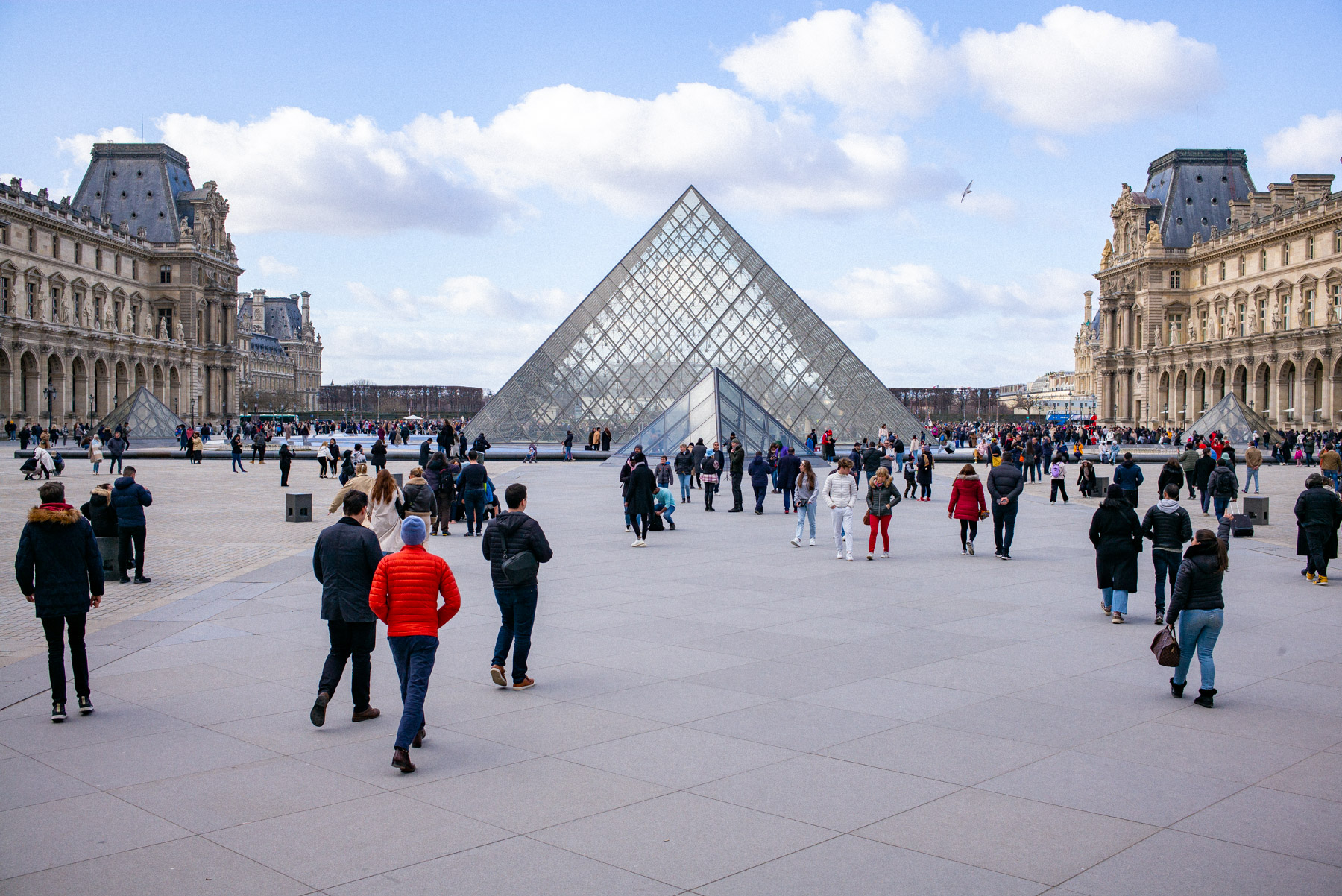
Post Overview: Best things to see at The Louvre
Few museums are known the world-over like The Louvre. No doubt it’s the crown jewel of all of France’s museums! It’s an iconic tourist destination, being the most visited art museum in the world (with 7.5 million visitors, annually!).
But with the museum’s impressive collection of more than 350,000 pieces of art, seeing it all is a daunting task. In fact – if you spent 30 seconds at every piece of art on display at the Louvre it would take you 200 days to see it all!
So what do you do when you’re only in Paris a few days? You make a list of all the best things to see at The Louvre and start checking them off, one by one! You have to resign yourself to the fact that you won’t see everything, but that’s okay. This just gives you ample reason to return.
Over the course of my years visiting Paris (sometimes for a month at a time) I’ve visited The Louvre around 10 times. By no means am I an expert (navigating the museum is no easy feat) but I feel I have a robust footing and understanding of the best things to see at The Louvre.
In this article I’ll go what to see at The Louvre and what makes the art pieces so special. From world-recognizable pieces (cough, cough, the Mona Lisa) to lesser known art pieces I’ll cover it all.
So whether this is your first or dozenth time visiting the museum, this article will help you make a list of the art you consider must see at The Louvre.
I hope you’re ready because we have a lot of ground to cover. What do you say we jump right in!
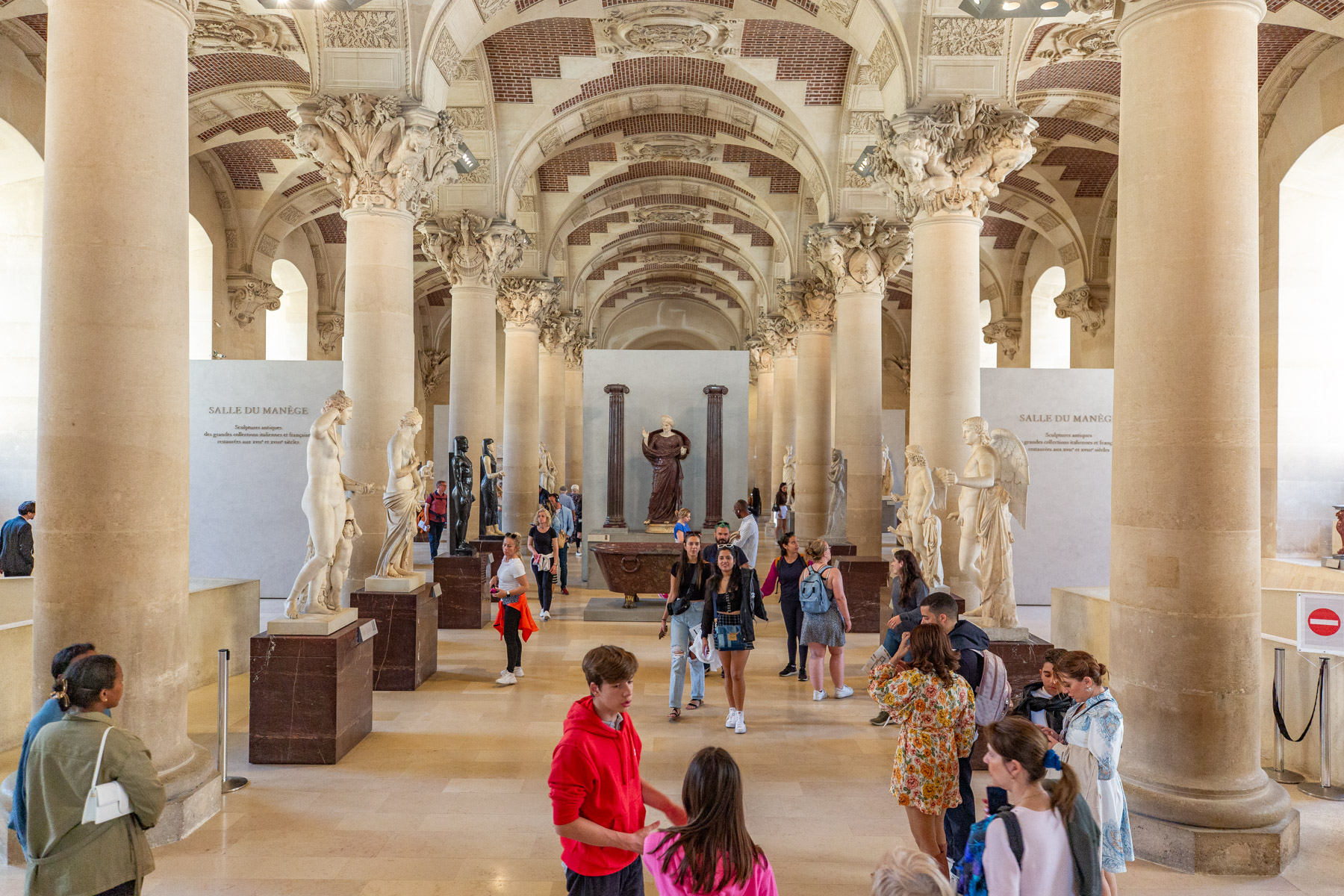
Tips for Visiting The Louvre
Don’t rush the experience
The Louvre is the largest museum in the world. Therefore you have to be okay knowing you’ll barely scratch the surface during your first visit! Enjoy your time slowly, read the signs, learn about the artist and study the art. Allow your visit to the Louvre to act as an escape from the busyness of Paris.
Crowds are a guarantee so don’t forget to breath
As the largest museum in the world, the Louvre gets around 7.5 million visitors annually. This unfortunately means crowds are all but guaranteed. My best advice is to purchase your tickets well in advance because they do sell out. Then make a list of all the must-see things at The Louvre and start walking!
You can take photos at the Louvre
Visitors can take videos and photos at the Louvre, but selfie sticks, flash and lighting are prohibited. Popular things to see at The Louvre will often have a line of folks waiting for a selfie. Don’t be shy to grab the photo of a lifetime!
The Layout of the museum
The Louvre is a behemoth of a museum! It’s made up of five floors and three wings (Richelieu, Sully and Denon) named after notable french figures. This handy map will make it easier to get a lay of the land. I also found using the GPS on my phone helped me understand where in the museum I was, since I could reference the northern Richelieu wing against the southern Denon wing.

Best Things to See at The Louvre
Keep good company – that is, go to the Louvre.
Paul Cezanne
Most Famous Paintings at the Louvre
Mona Lisa
Could I start this post any other way? Is there anything else that is more of a “must see” at The Louvre than little Miss Mona Lisa? Folks travel to the museum single-handedly to see Leonardo da Vinci’s 16th century masterpiece!
The painting’s name comes from its subject, Lisa del Giocondo, a member of an Italian noble family. Mona roughly translates to ma’am or madam, and thus its name was born.
One of the most fascinating things about the Mona Lisa is that for 400 years the painting was seldom known about outside of art circles. It wasn’t until an employee of The Louvre decided to steal the painting in 1911 that its fame skyrocketed. The thief claimed to have stolen the painting to return it to Italy, its rightful home.
It was only missing for three years, but that’s all it took to become an icon. The theft of the Mona Lisa inspired an opera, two films and an Oscar-winning song by Nat King Cole (named Mona Lisa, too).
In the present the painting is arguably the museum’s crown-jewel. It’s one of the most popular things to see at The Louvre made evident by the snaking line that takes up most of the room it’s in.
The painting holds the world record for the highest insurance valuation in history at a jaw-dropping one billion dollars when adjusted for 2023.
But here’s my two cents: The Mona Lisa is unarguably a must-see at The Louvre but it shouldn’t be your only-see. I wouldn’t even wait in the line. Just give her a glance from the edges of the gallery (maybe throw her a wink or blow her a kiss) and keep it moving because there are plenty of other things to see at The Louvre.
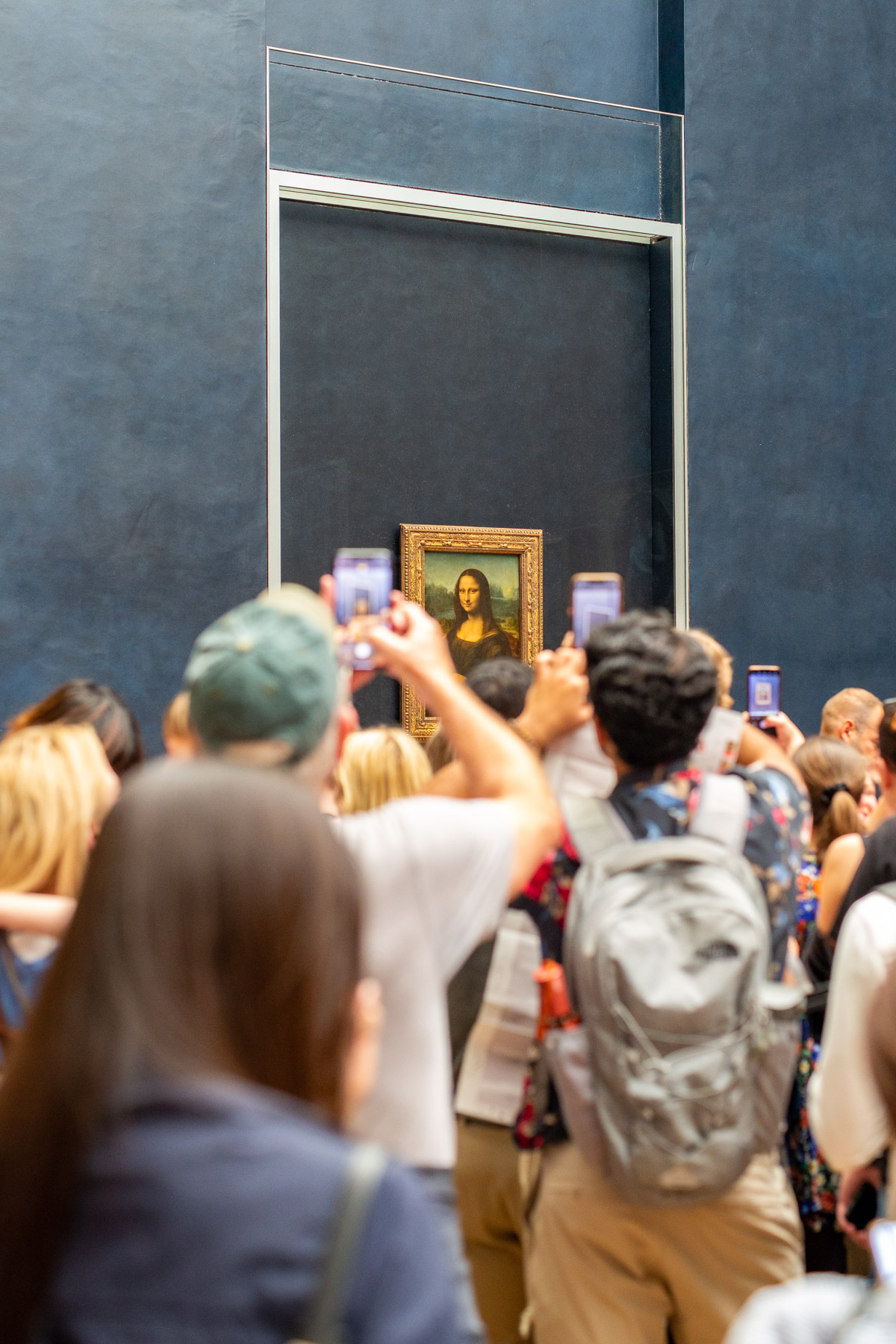
Coronation of Napoleon
Of all the things to see at The Louvre, Napoleon’s Coronation by Jacques-Louis David is the painting that stuck with me the most. During my first visit to The Louvre it stopped me dead in my tracks! As soon as I felt I was ready to keep it moving, a new detail would catch my eye and keep me there a few more minutes analyzing.
It depicts Napoleon I, already crowned at the Notre Dame, about to crown his wife Joséphine de Beauharnais, the first Empress of France. Behind him sits Pope Pius VII, whom Napoleon brought from Rome to crown him.
When Pius VII was set to place the crown on Napoleon’s head he snatched it from his grasp and placed it on himself, showing the pope who really holds the power. The original painting was meant to depict this notorious scene, but Napoleon is quoted as saying “I didn’t bring him [the pope] here to do nothing” and had the painting changed.
In the stands you’ll find Maria-Letizia Bonaparte, Napoleon’s mother who in reality was in Rome during the coronation. The willingness to toy with the truth (like making Napoleon look taller than he really was) makes Napoleon’s Coronation one of the earliest examples of political propaganda.
Among the crowd of 204 people depicted you’ll see members of the clergy, Napoleon’s siblings (including Joseph Bonaparte, who didn’t actually attend) and Jacques-Louis David himself. The massive painting will take a few minutes to dissect but is well worth it considering it’s one of the best things to see at the Louvre.
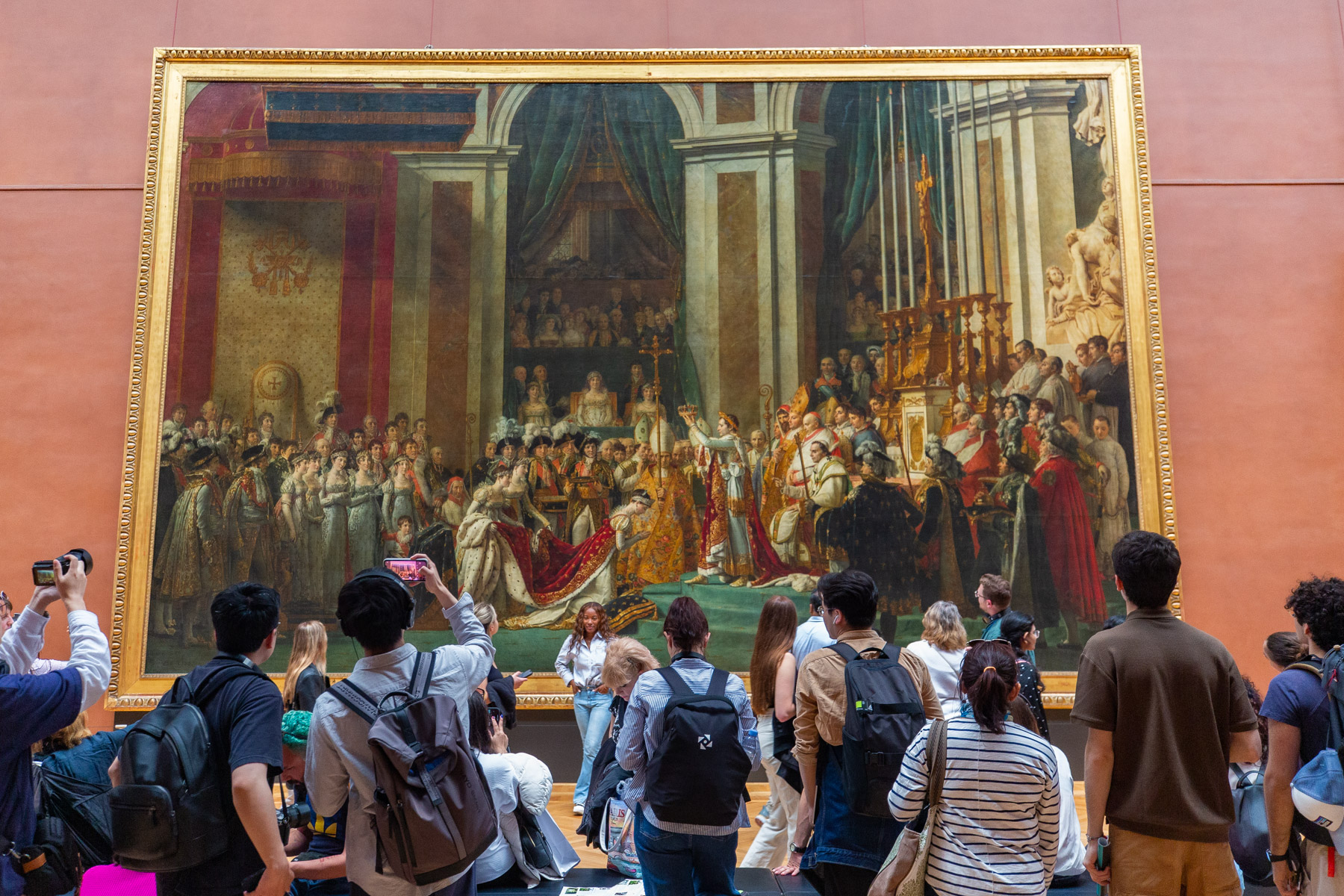
The Wedding at Cana
Whether you’re a Christian or not, most folks are familiar with the biblical story of Jesus turning water into wine. Jesus’ first miracle is seen in the gargantuan painting of The Wedding at Cana by Paolo Veronese, which needs to be on everyone’s list of the best things to see at the Louvre.
It’s the largest painting in the museum standing at an imposing 22 feet tall and 32 feet wide. The painting is even more impressive when you consider it’s more than 550 years old! At its center is Jesus, whose face is illuminated along with his mother at his side.
The bride and the groom are shown sitting on the left end of the table instead of at the center because Veronese wanted to make Jesus the central-figure. Also worth noting, Veronese included a self-portrait, making himself the musician dressed in white at the base of the table.
Take your time analyzing the painting because Veronese painted each person uniquely. There’s a woman cleaning her teeth with a toothpick, multiple animals and guests in middle-eastern garb.
Unfortunately the Wedding at Cana is displayed right in front of the Mona Lisa. With two of the best things to see at the Louvre right next to each other the gallery can turn into a zoo. And the line for a close up of the Mona Lisa can limit your view of the Wedding at Cana.

Death of The Virgin
Italian painter Caravaggio was an expert in using light and darkness to convey emotion. His painting, Death of the Virgin, is one of the best things to see at the Louvre and follows the painter’s renowned style.
In the early 1600’s when the painting was created, it ended up being controversial. It depicts Mary, the mother of Jesus, on her deathbed. From a purely artistic standpoint the painting is breathtaking, sharp and full of emotion.
However Mary’s face is tired and pale, her arms are outstretched and limp and her are feet swollen. Upon completion the painting was viewed as distasteful, and the original church it was commissioned for refused to display it.
Caravaggio stepped away from traditional representations of holy figures, instead choosing to paint a raw depiction of death. It was even rumored that he modeled a prostitute.
The painting made its rounds, being owned by royalty and noblemen all across Europe. It eventually was bought by King Louis XIV for the Royal Collection. After the French Revolution it became property of the state, and is has been one of the best things to see at the Louvre ever since.
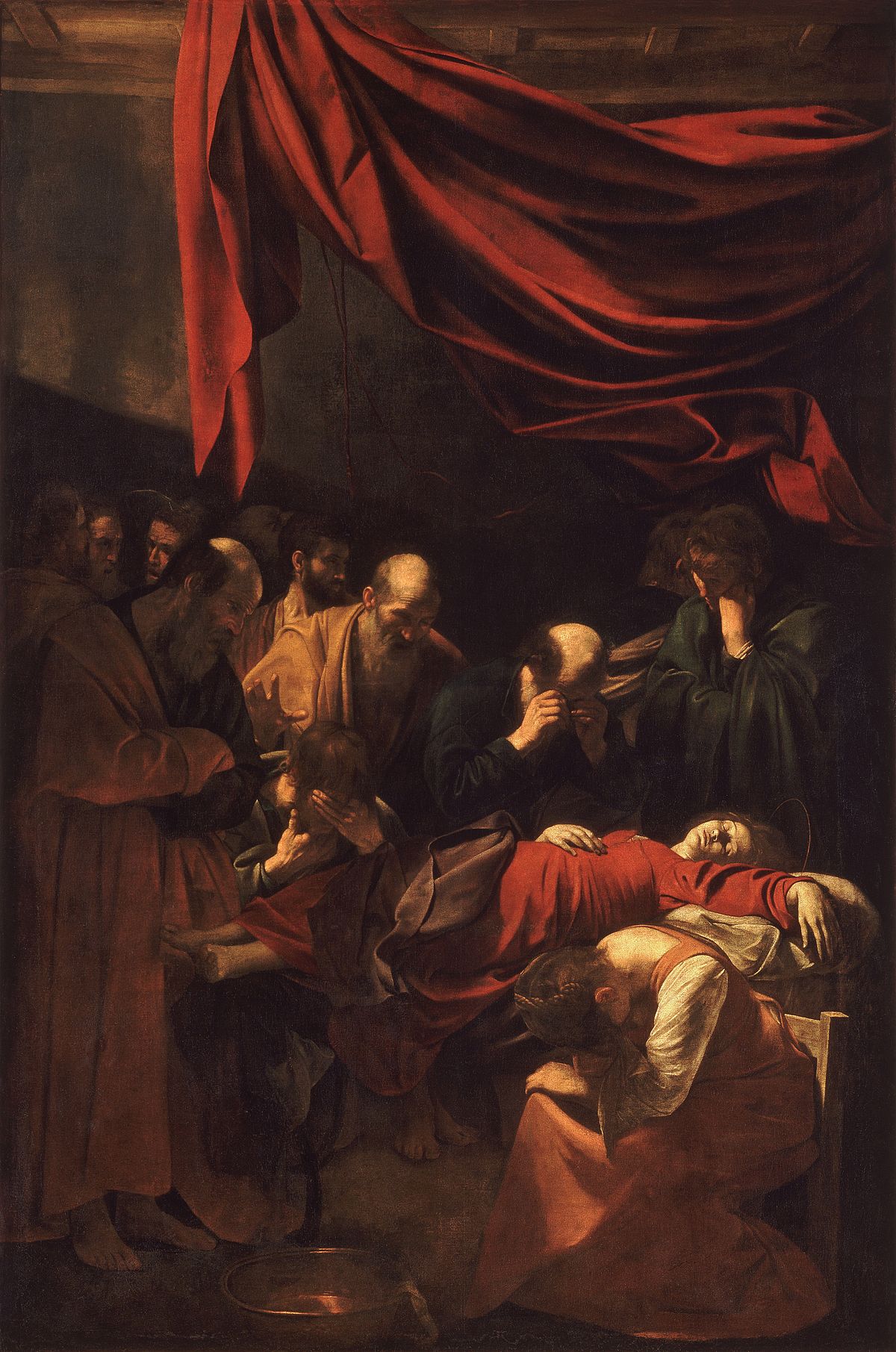
Liberty Leading the People
Eugene Delacroix was a renowned French painter who even has his own museum in Paris covering his art. His most famous painting however is one of the best things to see at the Louvre, titled Liberty Leading the People.
It depicts a personification of Lady Liberty leading revolutionaries over a barricade of bodies during the July Revolution of 1830. The crowd she is leading consists of Parisians of all walks of life, old and young, rich and poor.
Lady Liberty (also known as Marianne in France) is shown waving a colorful French flag in one hand and a bayonetted-rifle in the other. And if you look beyond the crowd Notre Dame stands in the background.
Without getting too much into the weeds, France had three revolutions and this is the one in the middle. Most folks think it depicts the original, first French Revolution but that is incorrect, these events took place 30 years later.
It’s also thought that Liberty Leading the People might have inspired Vicor Hugo’s novel Les Miserables. The painting has become synonymous with France. It has also helped stoke the fire of Patriotism for countless generations, and for that reason it’s one of the best things to see at the Louvre.
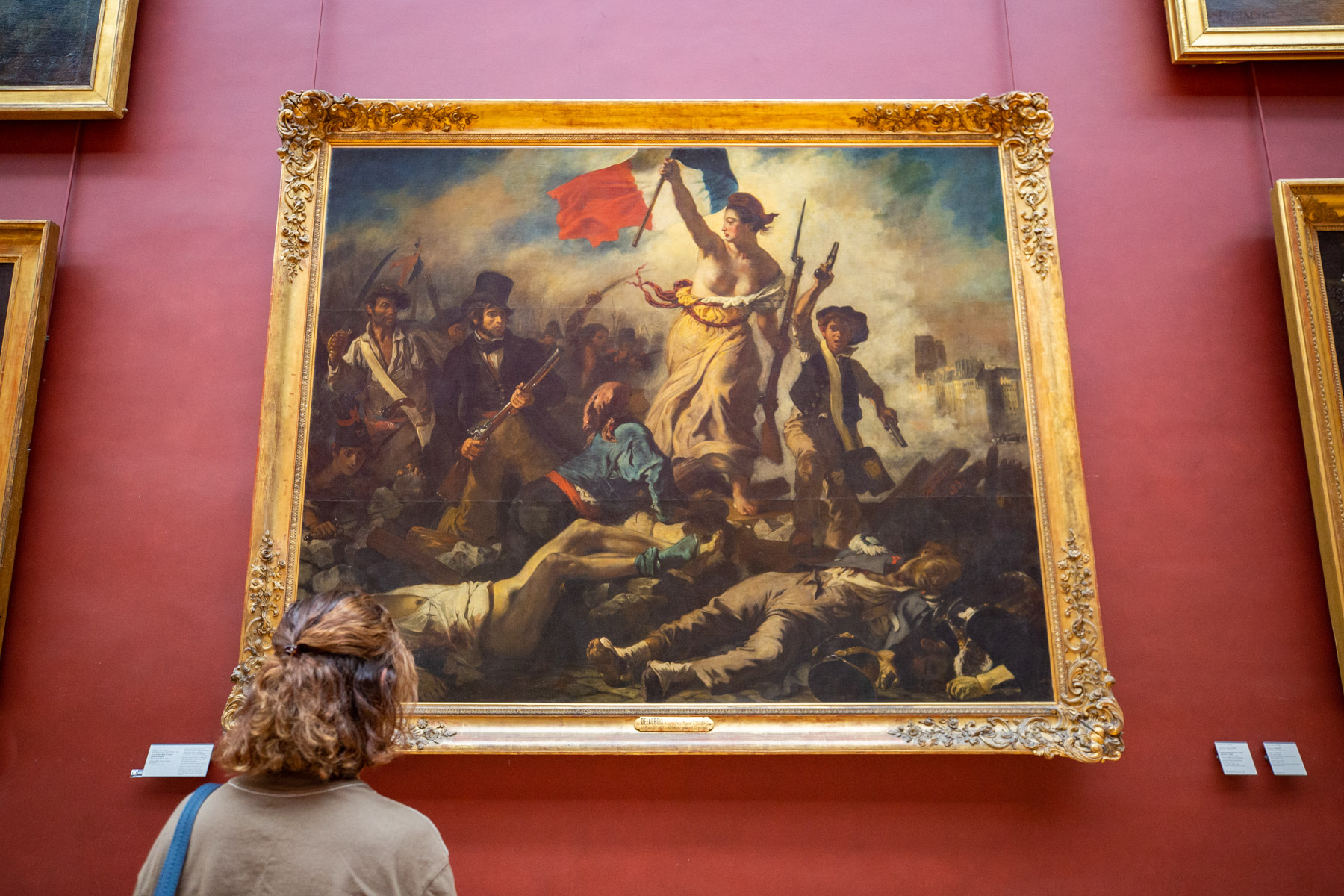
Oath of the Horatii
Jacques-Louis David, the painter of Napoleon’s Coronation is responsible for more than one of the best things to see at the Louvre. The Oath of the Horatii is a painting depicting a scene from an ancient Roman legend.
In the legend the cities of Rome and Alba Longa are at war. But instead of sending their armies to battle they decide to each send only three soldiers who are to decide the victor.
The Roman’s send three brothers of the Horatii family to represent them. In the painting they’re shown standing in unison, reaching for the swords their father is proudly handing them.
The painting was commissioned as a form of propaganda meant to instill a sense of loyalty to the state and therefore the king. Instead, a mere five years after it was completed, the French Revolution broke out and the Oath of Horatii was used as a symbol of self-sacrificial loyalty to one’s country.
When analyzing the painting from an artistic standpoint you really appreciate the compositional techniques Jacques-Louise David used to draw your eyes to certain parts of the frame. It’s considered one of the best things to see at the Louvre and a masterwork of the Neoclassicism-movement.
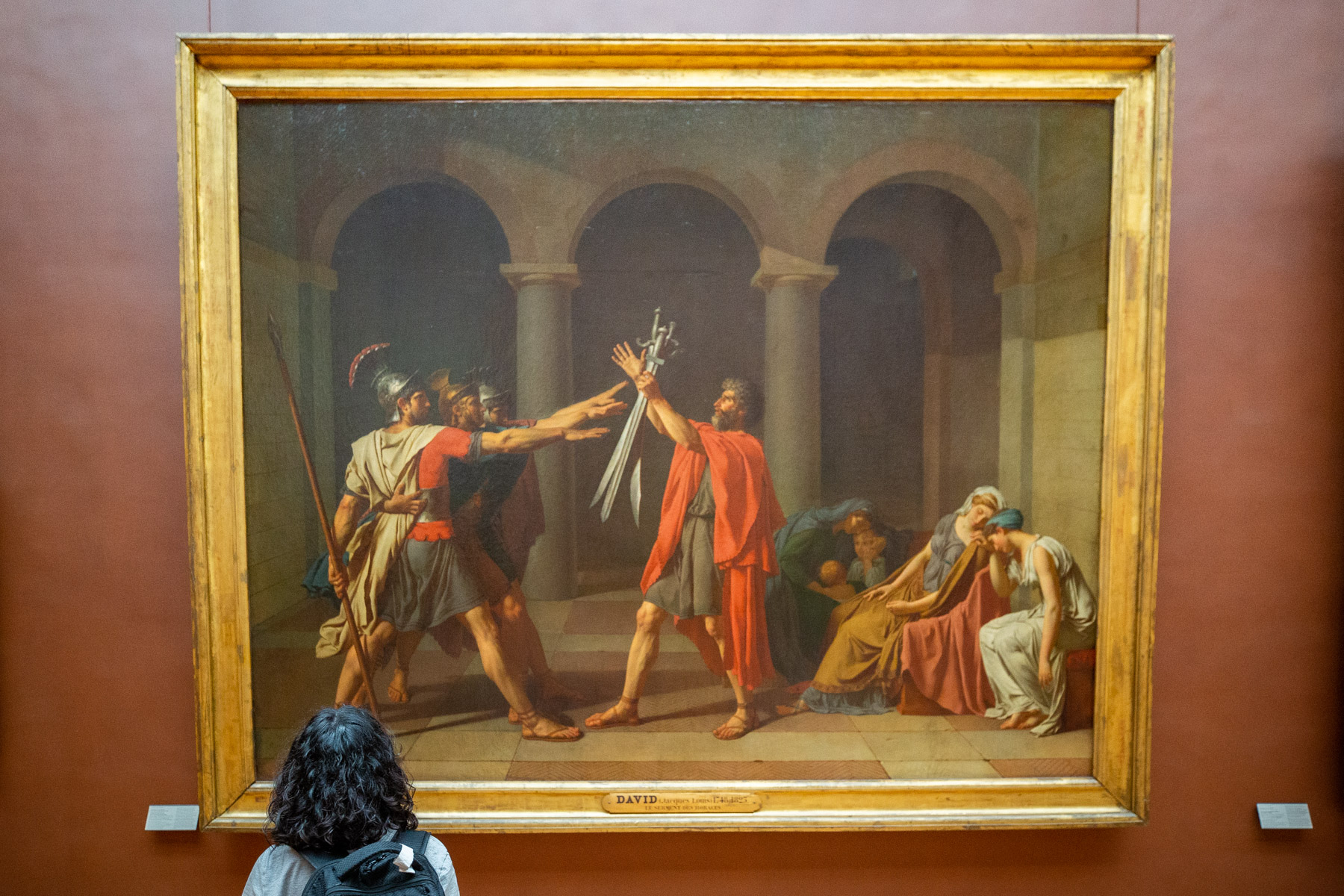
Raft of Medusa
The Meduse was a French Navy frigate (warship) that crashed about 60 miles from the coast of northwest Africa in 1816. There weren’t enough lifeboats so 147 people had to hop aboard a raft made from from the Meduse’s wreckage.
The lifeboats were supposed to tow the raft to shore. Sadly however they quickly cut the ropes when they realized how impracticable towing actually was. This left the Raft of Medusa at sea for 13 days! Of the 147 passengers only 15 would survive.
And one of the best things to see at the Louvre is the painter’s Théodore Géricault depiction of the chaos aboard that raft. He shows bodies of people who died from dehydration, murder and suicide. There are images of cannibalism and despair from the survivors. It’s a riveting display of painful agony.
Although it’s not the same as a photograph it’s pretty damn close and pulls on the universal string of tragedy. Géricault spent months researching the matter. He met with survivors, built a model raft, went to the hospital to study the faces of dying people and even brought back limbs to paint them as they decayed.
Raft of Medusa is not a masterpiece by happenstance, Géricault obsessed over the painting. It’s no surprise it’s one of the best things to see at the Louvre and one of the most famous paintings from the Romanticism-movement.
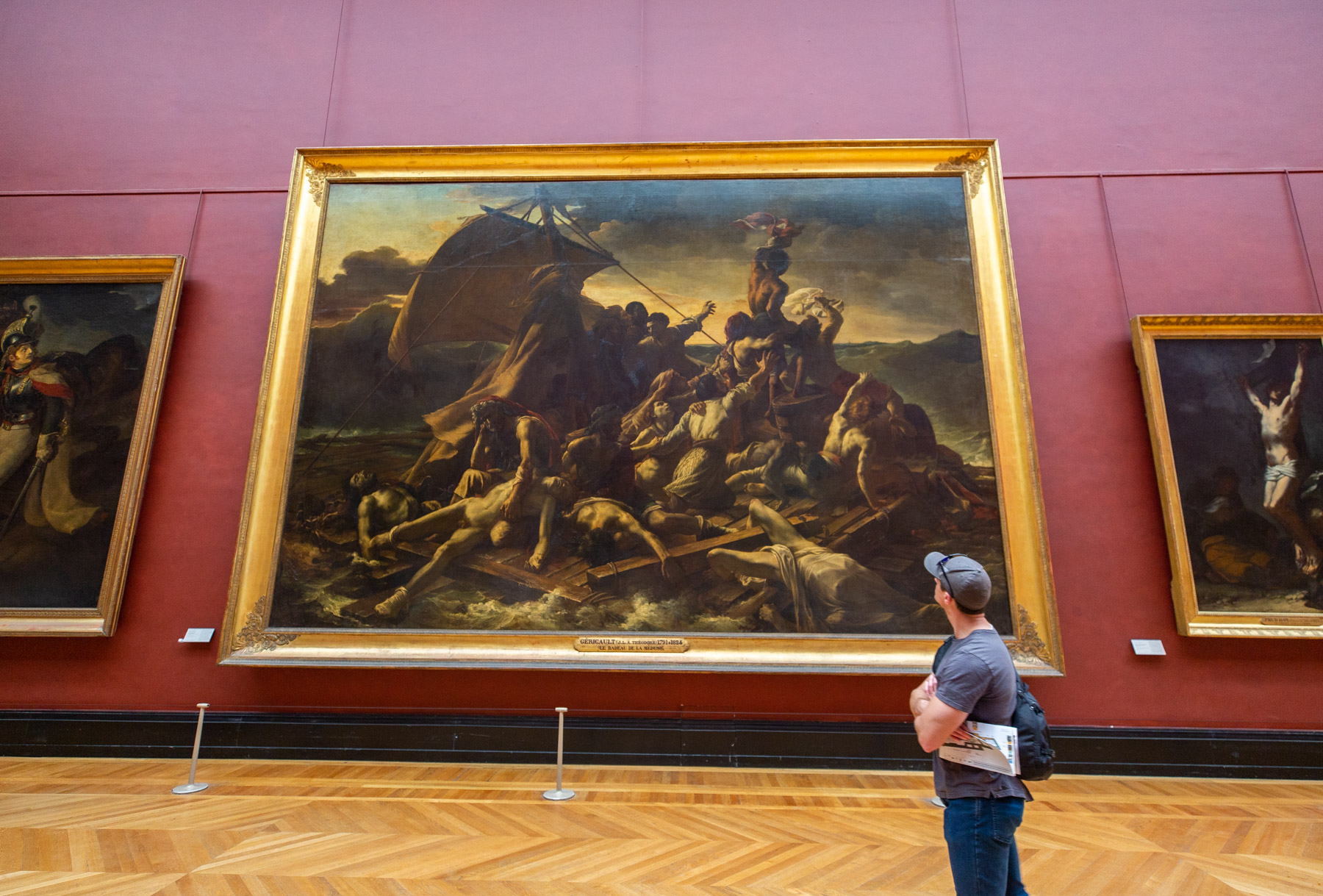
Must See at the Louvre (Not Paintings)
Now that we’ve wrapped the most famous paintings, let’s take a look at the other things to see at the Louvre.

Venus de Milo
The Venus de Milo is one of the best things to see at the Louvre, and recognized all around the world. It was discovered on the Greek island of Milos in 1820 by a farmer and bought by the Louvre where it has been ever since.
At the time of discovery the museum was desperate for classical-era art from ancient Greece and Rome (which was seen as the most desirable). This was because after Napoleon had been ousted a lot of his looted artwork was returned to their home countries.
It set the stage for the Venus de Milo to become an icon. They gave it a prime spot in the museum and claimed it a classical-era piece, when it was really from the following Hellenistic-era. Although the museum has since corrected its stance, the Venus de Milo is still one of the most popular things to see at the Louvre.
But regardless of the era, the Venus de Milo is ancient! It was built between 150 and 125 BC. The statue originally had arms, ears, and feet but through its 2000+ year history these have been lost. Nobody knows exactly what her arms were doing, but there were reports of her left hand holding an apple at the time of discovery.
I’ll admit that outside of being one of the most famous things to see at The Louvre the Venus de Milo is a piece of art that you can quickly check off your list and move onto the next.
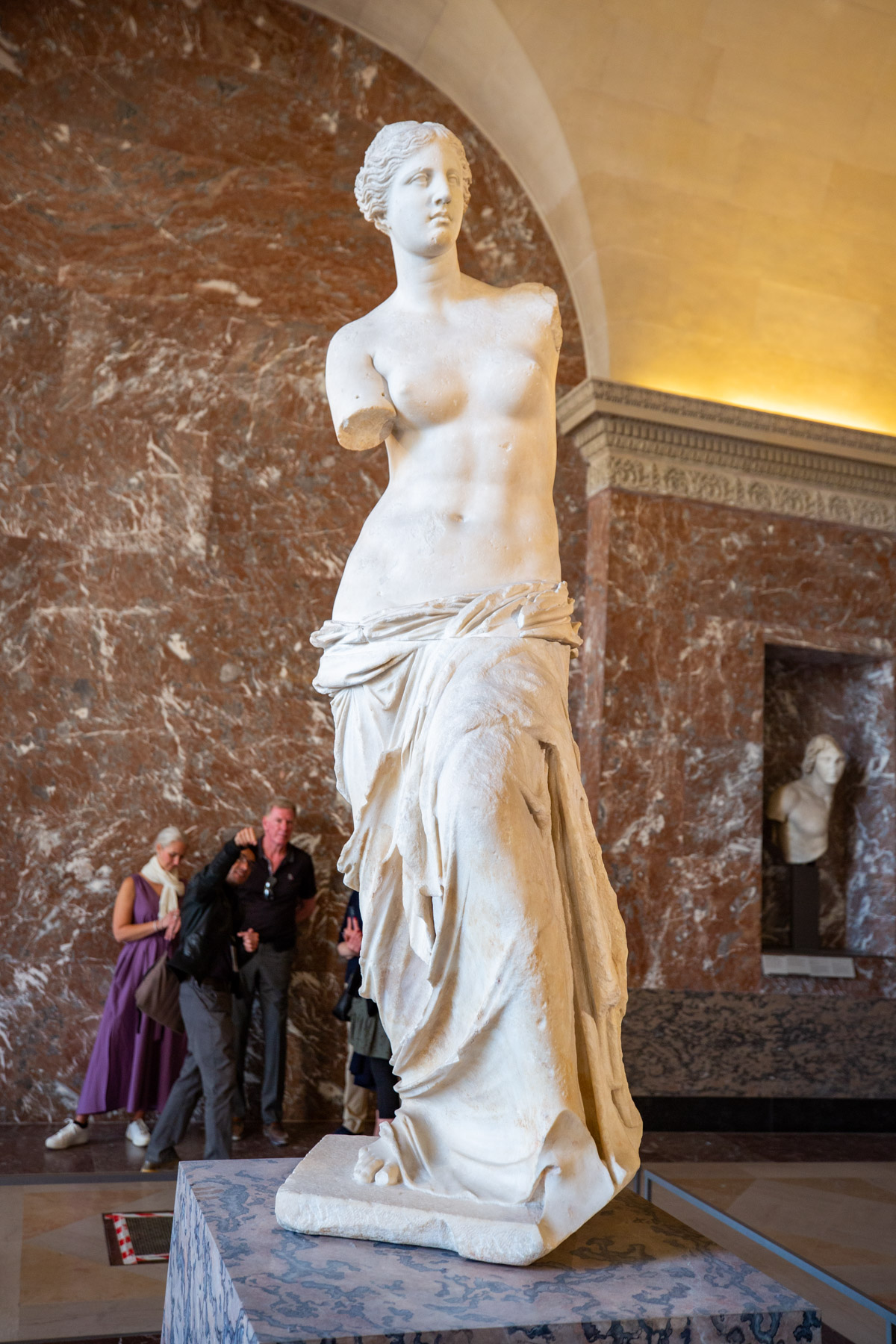
The Code of Hammurabi
Can you imagine having to read your country’s laws on a seven and a half foot slab of stone? Because one of the best things to see at The Louvre is The Code of Hammurabi, which was found by French archeologists buried in Iran more than 100 years ago.
Its discovery pales in comparison to the stone’s age, which dates to around 1750 BC. All things considered, for a 3,700+ year old piece of text it’s looking pretty good. It was also originally from Mesopotamia in Iraq, and only taken to Iran as plunder.
The text is written in an ancient Babylonian dialect and lays out the laws that King Hammurabi claims to have received from Shamash, the Babylonian Sun God (and God of Justice). It covers a wide variety of possible disputes including property law, family law and criminal law.
The Code of Hammurabi is one of the best things to see at The Louvre because of more than just its age. For example, it was one of the first legal texts to institute a presumption of innocence (and we love our rights).
The significance of the Code of Hammurabi is so great that a replica can be found in the United Nations headquarts in NYC and the U.S. Capitol has a relief portrait of Hammurabi.
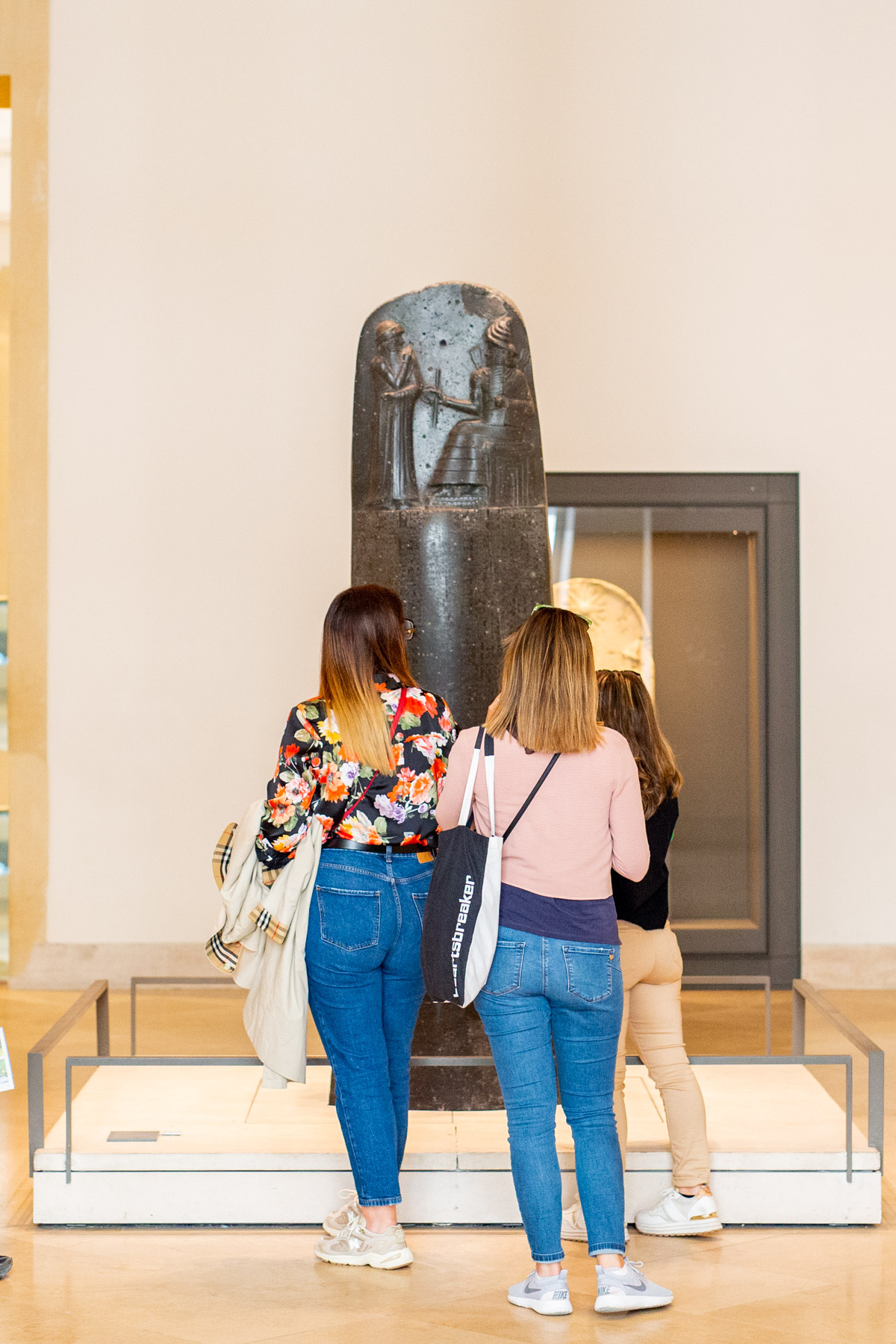
Winged Victory of Samothrace
The Winged Victory of Samothrace is a statue that sits majestically on top of a staircase and is one of the best things to see at The Louvre. The statue is of Nike, the Greek Goddess of Victory (and yes, that’s where the shoes got their name).
Originally she would’ve stood in the Sanctuary of the Great Gods on the Greek island of Samothrace. Sadly with the passing of the years she withered. In 1863 the statue was discovered in pieces, a bust here, a wing there – that sort of thing, and sent to The Louvre for restoration and reconstruction.
It quickly became one of the most popular things to see at The Louvre, thanks to its carefully carved wings and drapery. The statue’s garb appears to be flowing in the wind aboard a ship (like that scene in Titanic), frozen in time and movement.
For a statue that was carved around 200 BC it’s incredibly crisp and void of wear (you know minus the missing limbs). I’ll just warn you that the statue is among the most famous things to see at The Louvre and will always be accompanied by a swarm of folks looking for a selfie.
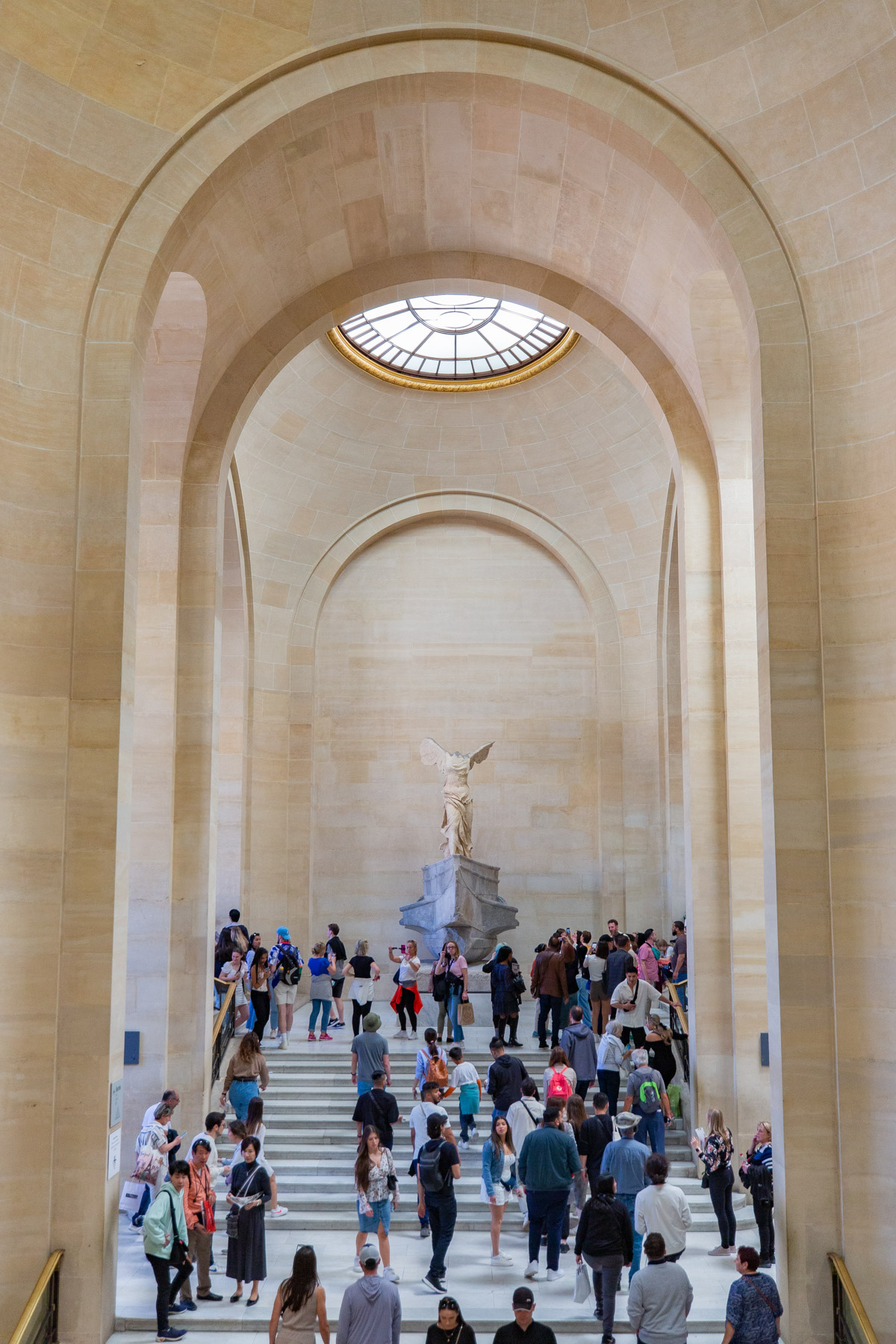
Appartements Napoléon III
Before the Louvre was the largest museum in the world it was a palace, notably the home to Napoleon III. That’s why one of the best things to see at The Louvre is Napoleon III’s apartment. A space that is the epitome of luxury.
Opulent chandeliers hang in nearly every room. Intricate woodwork and golden accents adorn the walls. There are paintings on the ceilings worthy of being in an Italian church!
Napoleon’s apartments put fairy tales to shame. The collection of rooms include a dining room, a living room and a bedroom that had me cursing my tiny NYC apartment with my first breath.
They’re truly magnificent and one of the best things to see at The Louvre. Plus they’re not nearly as busy as other parts of the museum. You can really take your time drooling over ever little detail without feeling rushed!
The Slaves
Michelangelo is one of the greatest artists of all time, so it only makes sense that one of the best things to see at The Louvre would be made by his hands. Hell, even this section of the museum is dubbed the Michelangelo Gallery (even though not all the work is his).
The two statues known as The Slaves are the crown-jewels of the Michelangelo Gallery. They were originally commissioned to decorate the tomb of Pope Julius II in one of the most famous churches in Rome, San Pietro en Vincoli.
They instead wound up becoming some of the best things to see at The Louvre. Surprisingly it wasn’t due just because of the name of artist who made them. Of the two statues, The Dying Slave is shown with his eyes closed, seemingly lost in his own thoughts. The Bound Slave instead seems very aware and looking for a way to escape.
Here’s my two cents, I think of the statues as examples of accepting fate. The dying slave looks to have accepted his fate albeit nervously. The bound slave struggles against his binds and looks up to God for help.
However you might see something different. That’s the beauty of art, more than five centuries later they still stir up conversation in its onlookers. The ability to develop your own opinion and discuss with your friends is one of the reasons The Slaves is one of the best things to see at The Louvre.
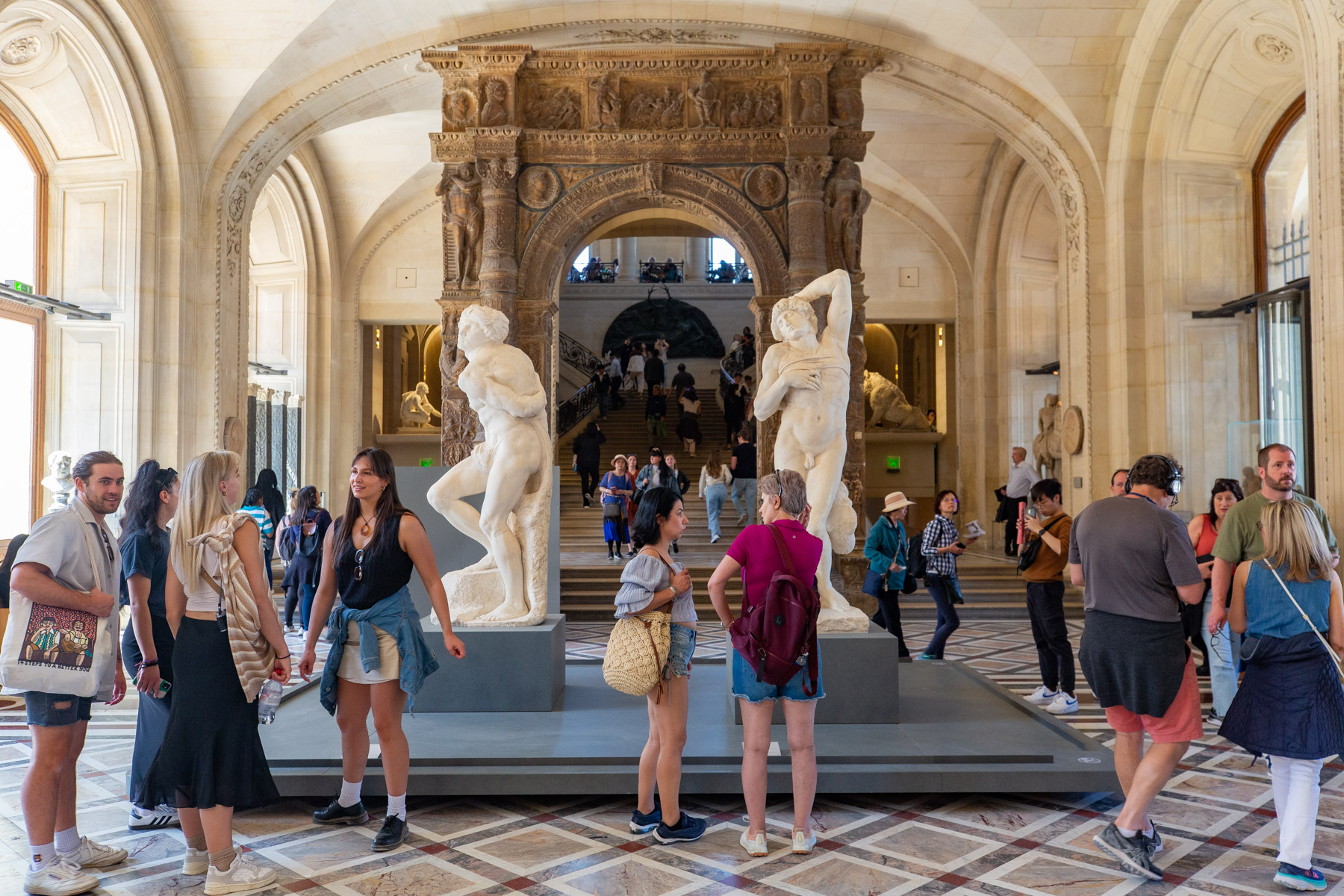
Sleeping Hermaphroditus
In 1608 near The Baths of Diocletian, one of the best museums in Rome, a statue of a sleeping Hermaphroditus was discovered from an unknown time. Claimed by Scipione Borghese it found a new home in the Borghese Gallery. Here, a young Gian Lorenzo Bernini was commissioned to carve a mattress for it to lay on.
Later it was sold to the French, who would make it one of the best things to see at The Louvre. For those unfamiliar with the story, Hermaphroditus was born the son of the Gods Hermes and Aphrodite.
However when a nymph grew obsessed with the boy she petitioned the Gods to unite them forever. The gods conceded and their bodies were merged. He thus has the reproductive organs of both a male and female, which is visible in the sculpture.
The statue has a near life-like feeling. And although I know the mattress is made of marble I still can’t help but want to lay on it. The sculpture is one of the best things to see at The Louvre, especially for fans of Bernini.
Extra time? More Great Things to See at The Louvre
Okay – you completed your must see at The Louvre scavenger hunt. What now? Lets go over some lesser known art pieces that may pique your interest. The kind of art you may not have intended on seeing, but now that you’re here you might as well enjoy.
Crown of Napoleon
I think if I had a crown made for my coronation, I would like it to bear my name. That’s a bridge we’ll (obviously) never have to cross. But Napoleon did and he chose to refer to his crown as the Crown of Charlemagne.
Instead of giving the crown a new name or calling it what everyone else did (the Crown of Napoleon), he gave the crown the same name as the ancient coronation crown of France that was destroyed during the Revolution.
Napoleon was effectively trying to tie his own history to that of famous French monarchs. Regardless of what you choose to call it, the crown is one of the best things to see at The Louvre.
I saw the crown of France laying on the ground, so I picked it up with my sword.
Napoleon Bonaparte
It’s faded and not as *shiny* as you would think, but is nonetheless a reminder of Napoleon’s power and status. Just because it doesn’t have the flashy diamonds or jewels we associate with crowns today doesn’t mean it’s not one of the best things to see at The Louvre.
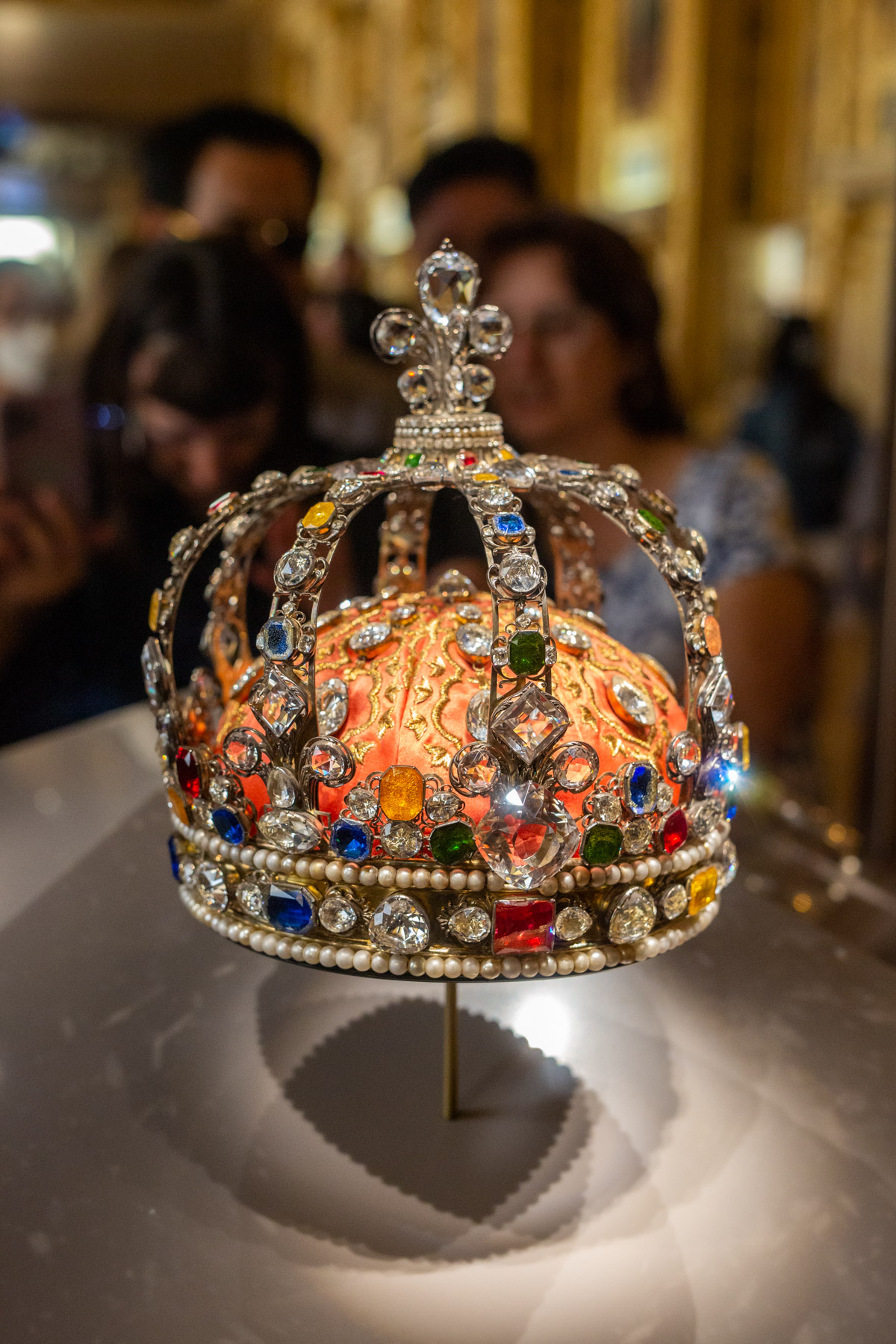
Le Pandemonium
John Martin was an English artist who was famous for painting small characters into vast, dramatic and striking landscapes. One of the best things to see at The Louvre is a prime example of this, a painting named Pandemonium.
Inspired by John Milton’s poem, Paradise Lost, where the Capital of Hell is also named Pandemonium. Martin painted a spine-chilling scene. Satan stands in the foreground with his arms raise, gazing upon the palatial capital engulfed in a sea of fire.
Martin is able to play with darkness masterfully. If you stare at the painting long enough it can almost feel like you’re there too. The masterpiece completed in 1841 is one of the most riveting paintings to see at The Louvre!

The Marly Horses
Any piece of artwork commissioned by a king will be a marvelous creation, and The Marly Horses are no exception. They’re large statues of horses coming up onto their hind legs (called rearing) with men at their sides.
The statues were commissioned by King Louis XV of France in 1743 for his royal residence, the Chateau de Marly (hence the name). It took two years to complete but the result became on the best things to see at The Louvre.
They were carved out of Carrara marble by the skillful hands of Guillaume Coustou. He served as the official sculptor for both King Louis XIV and King Louis XV. The Marly Horses are his most famous (and last) creation.
In 1794 the statues were moved to the Place de Concorde where it was determined they’d be safer. Today they stand as one of the best things to see in The Louvre. You can still see full size replicas in the Place de la Concorde but nothing beats the originals. 😉

Diana of Versailles
Diana of Versailles is an ancient Roman statue and one of the best things to see at The Louvre. It’s a totally badass portrayal of the Roman goddess Diana. Reaching for an arrow in her quiver with one hand and in the other is what appears to be the remnant pieces of a bow.
She has a small deer at her feet and the texture of her hair and clothing are astounding to say the least. The statue was a gift from Pope Paul IV to King Henry II of France. And my friends that is quite a generous gift!
Nobody knows definitively where or when the statue was found. With that said, archeologists are confident it was made between the first and second centuries. And even with her age, she is a replica of an older bronze, Greek statue from around 325 BC which has since been lost.
The statue is one of the best things to see at The Louvre and has inspired replicas all around the globe. For example King Charles I of England received a bronze copy and even the Titanic had a miniature-replica in its first class lounge.
Palace of Darius
It’s easy to forget that there were monolithic, ancient palaces outside of Greece and Rome. One of these grandiose buildings was the Palace of Darius in Susa, Iran built in the 6th century BC.
And one of the 36 columns that helped support the palace’s roof is an absolute must-see at The Louvre. It features two kneeling bulls facing in opposite directions and towers over visitors reading its plaque. Only the top part of the column is on display. In its entirety it would’ve stood at more than 70 feet tall.
The palace was more than just one building, it was the capital of the Achaemenid Empire of Persia. The column would’ve supported the roof of the audience hall, which was used for the king to hold meetings with the public.
The entirety of the wing is dedicated to the Palace of Darius but there’s no doubt the column is the gallery’s crown-jewel.
The Palace of Darius Wing is one of the more secluded parts of The Louvre. It takes a little bit of a trek to get there, but if you have the time it’s worth it. Not only is the column from the Palace of Darius one of the best things to see at The Louvre, but it’s void of the same crowds that plague the rest of the museum.
Fun fact: The Code of Hammurabi was uncovered in Susa, Iran. Remember – it was originally from Iraq but pillaged and brought to Iran where it was re-discovered by French archeologists.
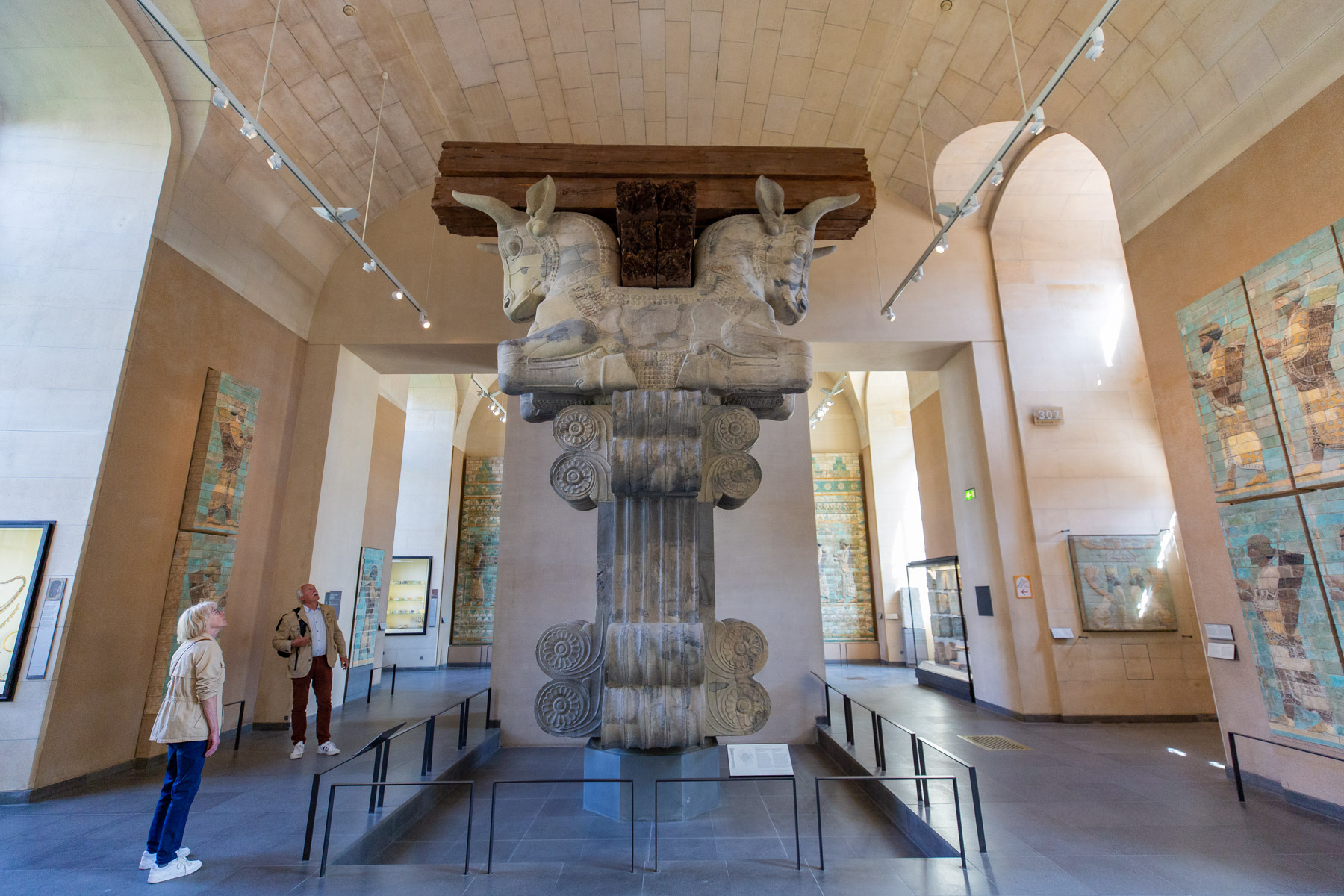
Great Sphinx of Tanis
The Great Sphinx of Tanis is one of the oldest things to see at The Louvre. The creation dates back as early as the 26th century BC (hot damn). Impressively it’s only missing a paw and its nose, which are small prices to pay for a 20,000+ year lifetime.
After coming into The Louvre’s posession in 1826 the Sphinx has called a few locations in the museum home, including a courtyard for 20 years. Fortunately it was brought inside and its new home is the Crypt of Sphinx.
You’ll find it at the end of a stairwell. Gazing back at its onlookers who are snapping photos with camera phones. I can only imagine the stories it would tell if it could talk. Like how in the good ol’ days folks wrote hieroglyphs not all this fancy texting and Tweeting.
The entirety of the Egyptian wing is a must see at The Louvre! But unarguably the Sphinx of Tanis should be your #1 priority. At the end of the day it’s one of the few sphinxes in the world with a crown, so it is royalty. 😉
What to see at The Louvre in Paris (Post Overview)
In summary, here’s the best things to see at the Louvre:
- Great Sphinx of Tanis
- Palace of Darius
- Diana of Versailles
- The Marly Horses
- Le Pandemonium
- Crown of Napoleon
- Sleeping Hermaphroditus
- The Slaves
- Appartements Napoléon III
- Winged Victory of Samothrace
- The Code of Hammurabi
- Venus de Milo
- Raft of Medusa
- Oath of the Horatii
- Liberty Leading the People
- Death of The Virgin
- The Wedding at Cana
- Napoleon’s Coronation
- Mona Lisa
And there you have it! My list of the best things to see at the Louvre. I hope you find the post helpful. Per usual, if I missed one of your favorites don’t hesitate to let me know.
Enjoy the museum, cheers!


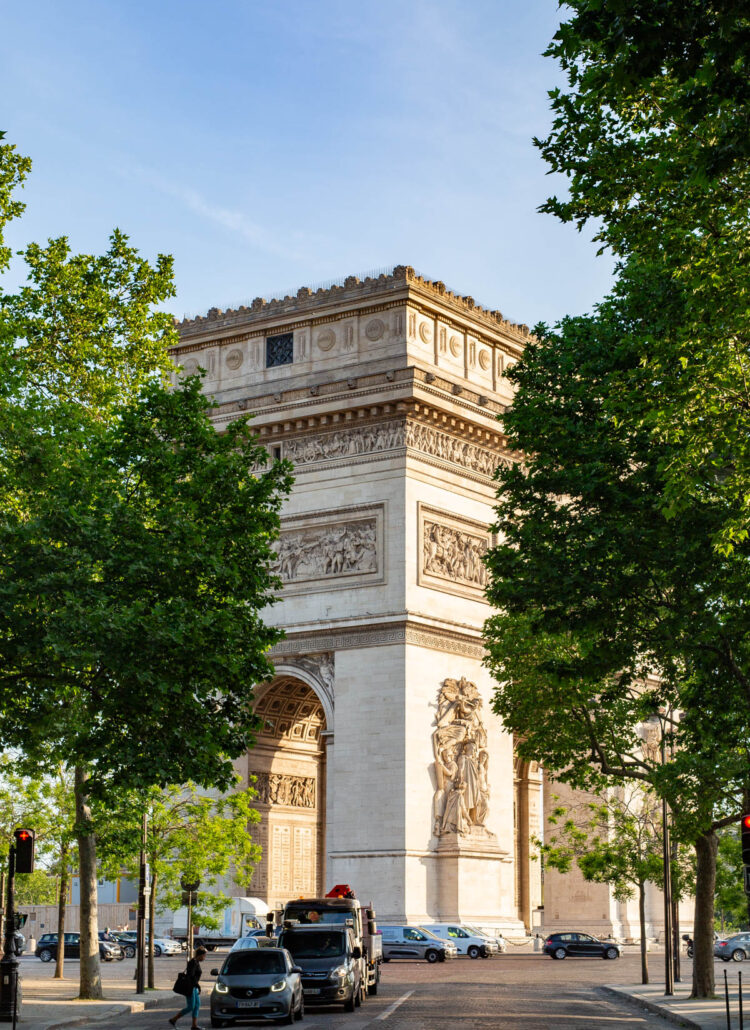

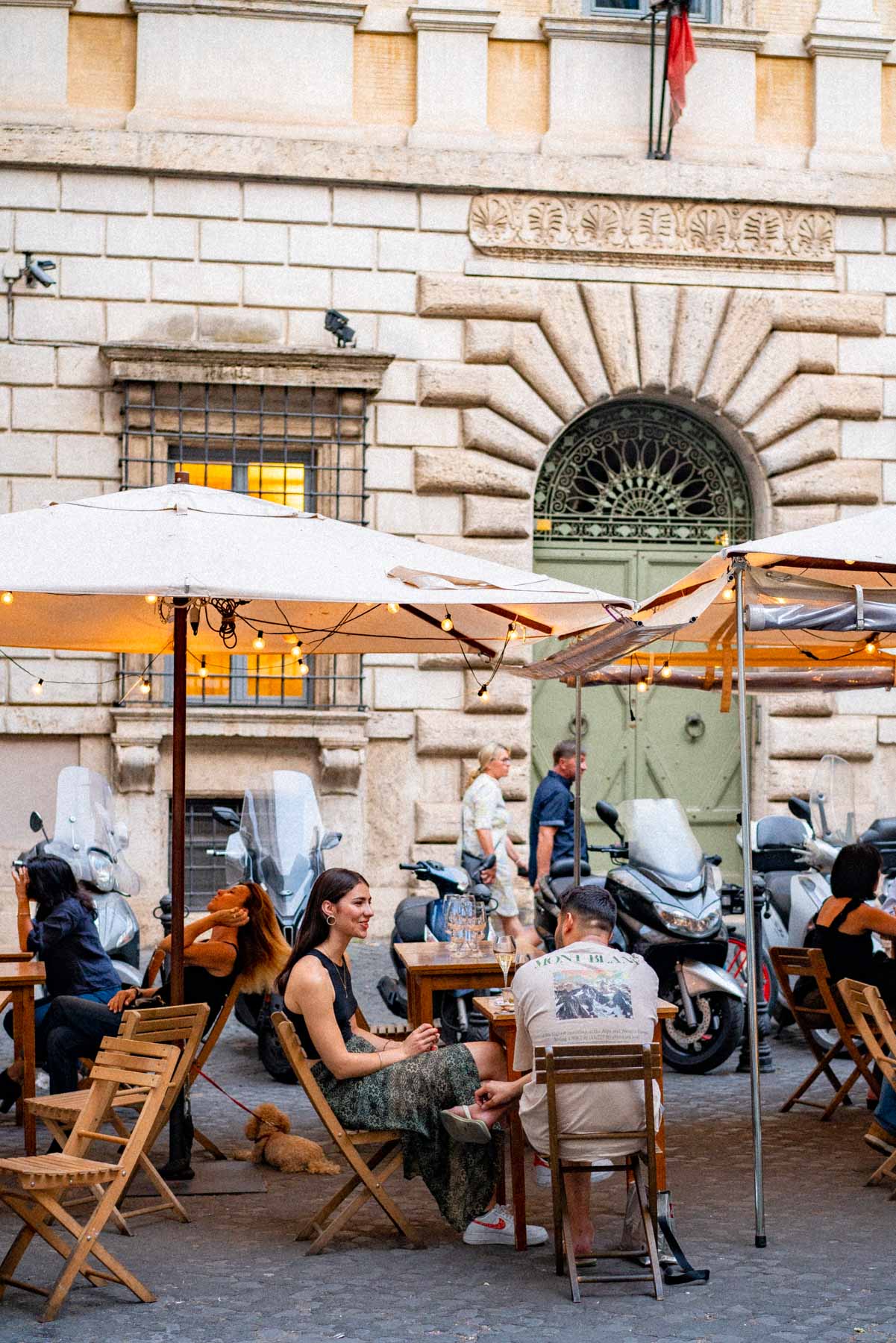
What do you think?